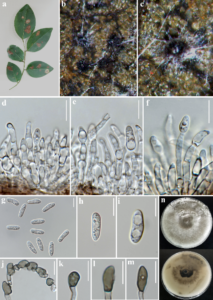Colletotrichum endophytica Manamgoda, Udayanga, L. Cai & K.D. Hyde, Fungal Diversity 61, 107–115 (2013)
Index Fungorum number: IF 565248; Facesoffungi number: FoF 14040; Fig. 1
Associated with the symptomatic leaf of Dalbergia. Sexual morph: Undetermined. Asexual morph: Conidiomata acervuli, solitary, superficial, rounded, and dark in color, setae not observed. Conidiophores (16.5–) 19–26 (–28) × 3–4 µm (x̄ = 22.5 × 3.3 µm, n = 25), hyaline, smooth-walled, aseptate, unbranched, cylindrical to clavate. Conidia 13–17 × 4–5 µm (x̄ = 14.5 × 4.8 µm, n = 25), straight, abundantly cylindrical, rarely ovoid with rounded ends.
Culture characteristics – Colonies on PDA reaching 70–77 mm diam. after 7 days at 25–28 ◦C, aerial mycelia medium dense, cottony, circular, undulate, white to olivaceous grey, reverse black color. Appressoria formed in slide culture on PDA measured 6–11.5 (−13) × 3–6.5 μm (x̄ = 8.5 × 4.5 µm, n = 20), formed from mycelia, terminal, brown, variable in shape, irregular unlobed or lobed, appressoria complex formation present.
Materials examined – Thailand, Chiang Rai Province, Mueang, Huai Sak, Ang Kep Nam Nong Buak Tao Reservoir, from a symptomatic leaf of Dalbergia, 27 September 2021, A. Armand (MFLU 22-0172), living culture MFLUCC 22-0107.
GenBank accession numbers – ITS: OP648261, β-tubulin: OP712674, gapdh: OP712673, chs-1: OP712672, act: OP712671.
Known distribution (based on molecular data) – Thailand (Manamgoda et al. 2013, this study), China (Zhang et al. 2022), Sri Lanka (Dissanayake et al. 2021).
Known hosts (based on molecular data) – Pennisetum purpureum (Manamgoda et al. 2013), unidentified wild fruit (Udayanga et al. 2013), Philodendron bipinnatifidum (Zhang et al. 2022), Mango (Li et al. 2019), Coffee (Cao et al. 2019), Chili (Diao et al. 2017), Dalbergia sp. (this study).
Notes – This species was distributed in tropical regions (Manamgoda et al. 2013, Dissanayake et al. 2021, Zhang et al. 2022a). Our strain shares similar colony and micro-morphology with the type material and is in agreement with the morphology of Colletotrichum endophytica. Multi-loci analyses using ITS, act, gapdh, chs-1, and β-tubulin reveal that our strain clusters with other C. endophytica strains reported from different hosts (Fig. 55). Manamgoda et al. (2013) described C. endophytica (MFLUCC 13-0418) as a new species from Thailand and this is the first known record of the occurrence of C. endophytica on Dalbergia.

Fig. 1 – Colletotrichum endophytica (MFLUCC 22-0107, a new host record). a Host leaves. b–c Acervuli on the host. d–f Conidiogenous cells and conidia. g–i Conidia. j–m Appressoria. n Upper and reverse side of culture. Scale bars: d–m = 10 µm.
